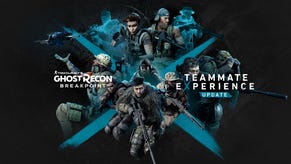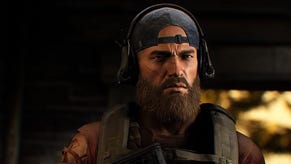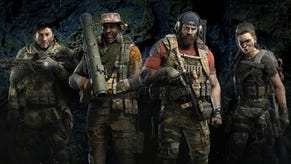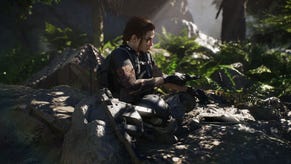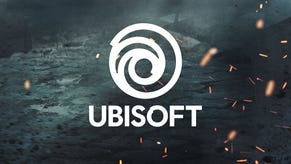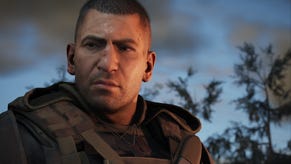Inside Ghost Recon Breakpoint: How Ubisoft is Mixing the Wildlands Formula With Survival, RPG Mechanics, and Even Raids
The next Ghost Recon will stretch you to the limit.
This article first appeared on USgamer, a partner publication of VG247. Some content, such as this article, has been migrated to VG247 for posterity after USgamer's closure - but it has not been edited or further vetted by the VG247 team.
My squad has encountered the enemy. I could have followed them through the infiltration point, but given my skill set, I decided to stay outside the target compound. Now I'm dropping targets with my sniper rifle, keeping them off the team. There's two soldiers headed my way though: a basic grunt and a heavily-armored lad with a machine gun. One shot, and the grunt is down. The heavy is searching for me, but he walks right by me. I'm hiding in what amounts to plain sight, thanks to a hastily-made camo of dirt and scrub brush. Two shots to the back of his head as he walks away puts him down.
At an event offering the first look at Ghost Recon Breakpoint, the latest in the long running series of Tom Clancy-inspired shooters, I'm initially left with worry. Ghost Recon Wildlands became a comfort game for me after its 2017 release. I'm not huge on military shooters, but it was a fun open-world romp. It was the kind of game where you and three friends could clamber into a stolen vehicle, go careening down the side of a mountain, and miraculously survive the experience. It was dumb in the same way Grand Theft Auto is dumb, in style of play where the developer opens up a playground and tells you "do whatever you want."
Enter Ghost Recon Breakpoint, which is a continuation of the story established in the recently-released Operation Oracle update. Ubisoft's presentation leans heavily on the military side of the Ghost Recon experience. While political agendas and governments change, the "only constant is those fighting beside you," stresses Breakpoint writer and former Green Beret Emil Doubon. He outlines a game that's supposed to bring the player "closer to the experience of real special operations."
Thing is, that's not necessarily the game I played.
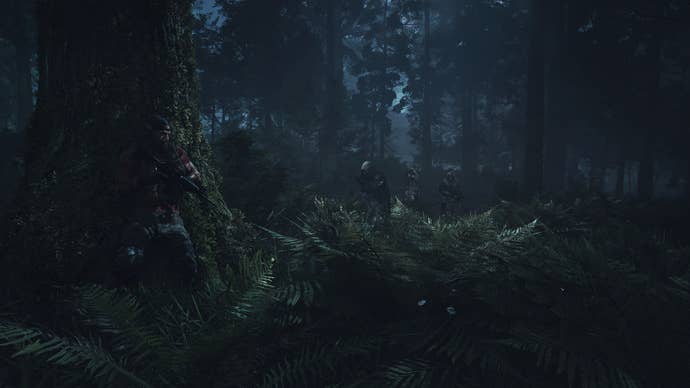
First Blood - Ghost, Not Ghosts
Like Wildlands, Ghost Recon Breakpoint springs from an alternate reality that Ubisoft has created. Skell Tech is a fictional company that's well-known to avid Tom Clancy players. It's the tech giant behind the drones the Ghosts use in Wildlands; the camo technology in Ghost Recon: Future Soldier; the main supplier for Splinter Cell's Fourth Echelon, and the drone tech of Rainbow Six Siege operator Twitch. The company rose in prominence with the Splinter Cell Special Operation in Wildlands and the Operation Oracle update, where you had to join with fellow Ghosts team leader Cole D. Walker to save a Skell Tech engineer.
That leads directly into Breakpoint, which begins when Auroa Island, Skell Tech's private headquarters, goes silent. The Ghosts are sent in to find out why Auroa Island is off the grid, and the entire squad is attacked by a drone swarm. There's a layer of unreality to Breakpoint's opening, with this living stream of drones moving like mechanical bees, tearing through full-fledged military helicopters. The attack leaves your Ghost alone, hunted by an opposing force that knows all the Ghosts' tactics.
The attack is perpetrated by the Wolves, a group of soldiers cosplaying as Star Wars' Knights of Ren, all of whom happen to be former Ghosts. And their leader is Cole D. Walker, your former friend and ally, portrayed by The Punisher and The Walking Dead actor Jon Bernthal. It's rare for Ghost Recon to rely on named actors for its characters, but according to Ghost Recon senior producer Nouredine Abboud, Ubisoft "needed a nemesis that was strong enough to keep you playing."
"What we wanted in terms of storyline, since the theme of the game is the 'breakpoint,' is to have a mirror of the Ghosts. That's the reason we developed the Wolves. You have the Ghosts vs. the Wolves. You have you and you have Cole D. Walker, the two leaders. We wanted to have someone charismatic. The first actor I wanted for the role was Jon, because he has this subtle way of expressing emotions. Since Cole was your friend and he betrays you, we didn't want to write a caricature. We wanted the players to understand his motivations," Ghost Recon Breakpoint creative director Eric Couzian tells me in an interview.
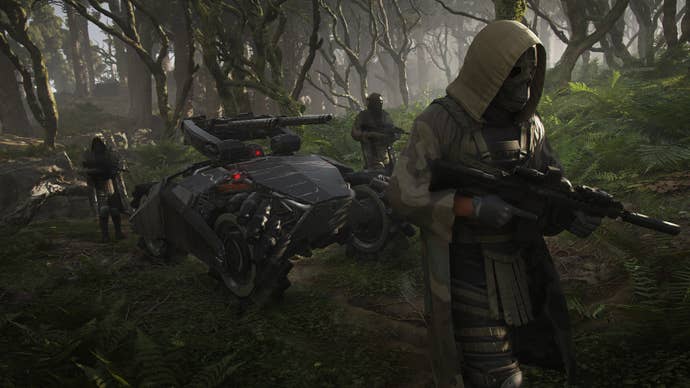
Judgment Day - Bring Out the Drones
Drones are the focus of Breakpoint. Walker and the Wolves are the primary enemy, but their overwhelming force is because of their takeover of Skell Tech's drone forces.
"Every Ghost Recon project, we start from a 'what if?' On Wildlands, it was 'what if drug cartels spread in South America?' Here, the what if is the automatization of the military." says Couzian. "That was the starting point. Then we read many things about drones and all the things happening in Silicon Valley with these giant tech companies. It's a piece of fiction; for us, it was quite fun to imagine that a Silicon Valley company could create working AI and robotics. We wanted to create a unique experience, very different from Wildlands."
Breakpoint really wants to bring players into the conflict with Walker though. There are "hours of cutscenes" in Breakpoint, and during my demo, I notice that there are actual dialogue options, which can offer up different intel. The target list returns from Wildlands, but it's mostly blank, being filled primarily with intel you've actually gathered. In the cutscenes, your Ghost is front-and-center; I saw the same cutscene play out for my squad and on their screens they were in the primary position, talking with the target scientist. There are also flashbacks, showing your Ghost during past missions with Walker. (The facial animation was a bit stiff in the demo.)
The narrative change for Breakpoint, portraying the player as a Ghost mostly alone behind enemy lines also means that solo play has shifted. You'll truly be alone, without the three AI buddies to keep you company. The Ghost Recon signature Sync Shot is still available though: you have up to three drones you can deploy to snipe targets with you.
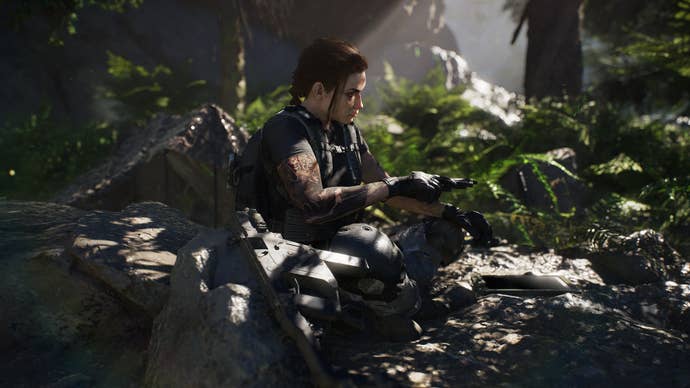
The Grey - Surviving Against the Wolves
The Ghost have always had a plan. They've always been ready with intel and briefings. Breakpoint wants to raise the stakes and put them behind enemy lines as the hunted. And to highlight that feeling, Breakpoint leans further into survival mechanics. You'll have to eat, drink water to stay hydrated, keep your weapons maintained, and even deal with random injuries.
Players have to think more about the terrain now, rather than just running up and down mountains. There's now stamina you have to keep track of, and steep slopes will require stamina to climb. Going down those same slopes will make noise, and if you go too far, you'll fall, causing injury. And those injuries will remain until you tackle them with field dressings at your bivouac.
The bivouac are the safe zones of Breakpoint, small camps where the Ghosts heal their injuries, change their gear, repair their weapons, craft rations and bandages, and change their classes. Breakpoint will launch with four classes-Assaulter, Sharpshooter, and Panther were the three shown in the demo-that allow you to focus your play style. For example, the Panther is a stealthy operator, using abilities like a smoke bomb to disorient enemies and kill them up close. Bivouacs also allow you to determine your entry conditions; there's a weather forecast showing what's coming up, so you can break camp during the night or day, or in the middle of a rainstorm.
For some, this hard focus on survival aspects sounds fantastic, but if you liked the more freeform Wildlands, Ubisoft doesn't want you to worry much. "What is very important for us is that you must not be misled by all the survival," says Couzian. "I think the game is as accessible as Wildlands."
Instead, Ubisoft sees the survival aspect as adding dynamic moments to your play. The potential to get injured while taking on a slope means that you're keeping track of the environment. And ultimately player choice remains a huge aspect of Breakpoint. "We want the world to be part of your experience. The world can affect you badly or in a good sense. It's a real balance. Moreover, there are different levels of difficulty that you can select. If you don't want to go into this aspect, it's easy to get rid of it. It's a question of tuning. You can play arcadey if you want, or more into the simulation way," adds Couzian.
The details make Ghost Recon Breakpoint sound more survival-focused than it really is. This isn't Rust or anything like that. Weapon maintenance, for instance, is really just a buff to make your weapons better. You'll never have a gun outright break because you didn't keep track of the maintenance.
Injuries are another aspect that intends to add more dynamic play, not tedium. There are three injury levels that will change your physical performance, and the calculation of whether you get injuries is apparently "quite complex." "The main parameters are your level of stamina, your class-which can affect your ability to be injured-and the type of damage you take.
"For us, it's very easy to tune," says Couzian. "We didn't want it to happen too often, otherwise it's not fun. When you play, especially when you play with friends, you have your plan. And when you have an injury that happens during a gunfight, it's a real big change. Suddenly, you will have to ask your friends to come and help you. It creates a dynamic that's super-cool and positive, because it's real team play. You can imagine all the things that happen dynamically in a gunfight." Ubisoft is hoping that these new systems will enhance the wild combat situations you sometimes find yourself in the midst of; it wants to create experiences that lead to water cooler conversations.
This idea feeds into the things that didn't make the cut for Breakpoint. Auroa Island was built to offer a wide variety of biomes, which includes snow-capped mountain peaks and even a volcano. Given a survival focus, it'd be easy to add a system based on temperature, using gear to manage heat. Couzian says that Breakpoint originally had such systems, but it wasn't fun.
"At the very beginning of the project, we thought that temperature would affect your ability to move in the world. We got rid of this, because it was too hard to manage for players. You can customize your Ghost; it meant that every time the weather changed or you crossed to another region, you were required to have different clothes. It was really painful. What really affects you is the weight of equipment and the weather affecting your visibility," he tells me.
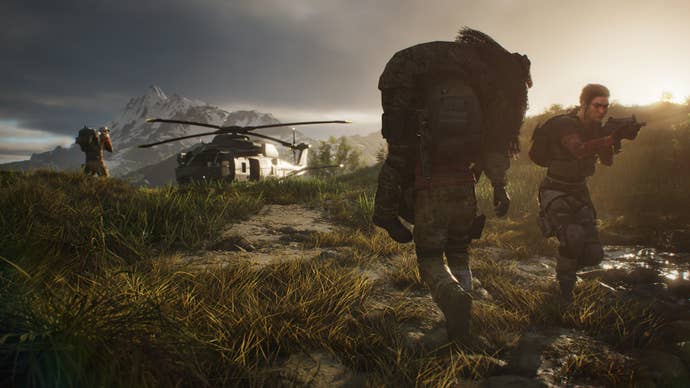
Lone Survivor - The Small Improvements
Still, the short demos I played of Breakpoint felt like Wildlands. The stamina meter was present, but I didn't get a strong sense of the other survival mechanics feeding into the experience; it simply wasn't a long enough playtime to gauge the full impact. But Breakpoint is Wildlands with improvements, mostly in some smaller areas that I think are much-needed changes.
In the demo I played, your squad is tasked with freeing Skell Tech scientist Paula Madera from an outpost in Auroa's Devil's Forest. Here the small changes come to the forefront. There's the new prone camouflage system, where if you go prone in certain areas like mud or scrub bush, you can hide yourself using the natural environment. It doesn't work everywhere-how are you going to hide on concrete or flat dirt paths?-but it gives you far more stealth options than before.
Or there's the new breach mechanic, allowing you to create permanent entrances in metal fences with a torch. If you're trying to get into a compound, one team member can simply open a hole that the rest can crawl through. You can also carry bodies, which is a major improvement over Wildlands. This allows you to pick up enemy bodies and hide them, or carry your teammates to safety. The demo mission saw Madera get shot in the leg, and I had to carry her to safety while my teammates covered me from an assault by the Wolves. (You can't run while carrying a body.)
Auroa Island is an occupied location, but the civilians don't know you're there. This means that they're supposed to react to the Ghosts, with some civilians actually notifying enemies to your position. (This was not entirely working in our demo, so it's more aspirational rather than functional at this point.) There are also more enemy types; not only are the Wolves more prepared than the Unidad or Cartels, they bring armored Heavies or the tank-like Aym Drones to the party. The drone adds an additional wrinkle, because it can't be stealth killed and its weakpoint is relatively small.
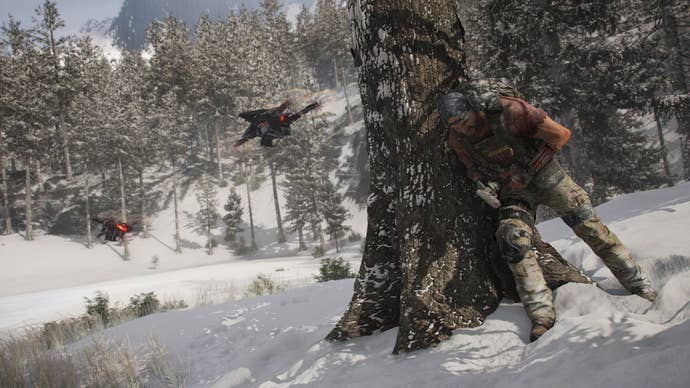
Breakpoint also shifts the progression system from Wildlands. In the previous game, you unlocked new guns by completing missions and tasks in various provinces. In Breakpoint, you take the weapons right off the bodies of your enemies. Downed enemies will give you some eSkel currency or a chance at a weapon or piece of gear. Maybe you find a hat, maybe you find a pistol. It's a very RPG-style of progression, without going full RPG like Assassin's Creed has. A headshot is still a headshot here, unless the enemy is wearing some head armor. "For the moment, what I can tell you is that you have systems where the enemies are at the same level as you. And you have areas in which they're extremely powerful and the difficulty level is fixed. Since we are an action game and it's skill-based, you can go there, but good luck," says Couzian. "We could say there's this kind of RPG progression in it, but Ghost Recon is a 'one bullet, one kill' game. Whatever weapon you have, we've built into the game that you stay in this action loop and the sense of progression is shared with PvP. It was very important for us that if you find a weapon in PvE, it doesn't give you further advantage in PvP. It's always skill-based."
Full Metal Jacket - On PvP and... Raids?
Yep, Ghost Recon Breakpoint will be launching with PvP. And unlike Wildlands, PvE and PvP progression and mechanics are shared. Your character in PvE will switch right over to PvP, and vice versa. Mechanics like prone camo will also factor into PvP play. Couzian says that Breakpoint's PvP should be like Wildlands' Ghost War, but declined to talk about specifics.
"Here, we expect that since you bring all the new features from PvE, it can help players to play in different playstyles. If you have prone camo in PvP and you have to manage your stamina, it means that there will be players that are specialized either in hiding or in helping other players to refill their stamina by crafting items. Even if you're not a super shooter player, in PvP you can help your friends without shooting bullets," he tells me.
Outside of the primary campaign, Ghost Recon Breakpoint will also offer raids, not unlike sister title The Division 2. These raids are endgame-level repeatable content that is built to be played in co-op. The raids take place on their own island, a drone factory that feels like something out of G.I. Joe. Ghost Recon Wildlands had two years worth of ongoing live service support, and raids will be a part of that for Breakpoint.
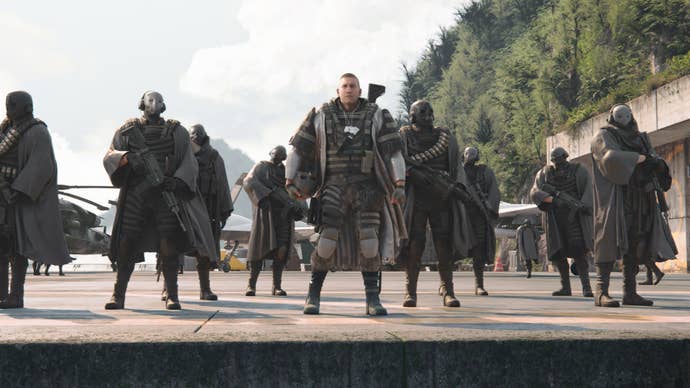
"We were very ambitious for the endgame. The raids are a part of all the activities in the game," sys Couzian. "Yes, it's an endgame activity, but since it's completely non-linear, it was important that you have these types of challenges, that are extremely hard and especially made for co-op. So we've designed an island specifically for the raids. It's a mini-open world, with several bosses in it. The island features a volcano. We had a dedicated team that only works on it, since the beginning of the project."
Ghost Recon Breakpoint closes out this generation of consoles, with an October 4, 2019 release on PlayStation 4, Xbox One, and PC. I was worried that Ubisoft might be leaning a bit far into the survival aspects, because while I like survival games, I really enjoyed the lighter play of Wildlands. From my brief time with Breakpoint though, I found a game that's like Wildlands 2.0. Similar play, with a host of changes and improvements to make for a more robust and dynamic experience. If Ubisoft can keep the military fans happy, while also providing me with a game where I can tear into an enemy encampment with a helicopter (or fight the Predator!), I think that's the sweet spot it should be aiming for. Currently, it looks like Breakpoint is on track.
Plus, I get to kill The Punisher. That's cool.




